
Illustration of the brain in blue and yellow
12 leading neuroscientists tackle a big question: Will we ever understand the brain?
Their reflections span philosophy, complexity, and the limits of scientific explanation.
www.sainsburywellcome.org/web/blog/wil...
Illustration by @gilcosta.bsky.social & @joanagcc.bsky.social
06.08.2025 08:41 — 👍 15 🔁 3 💬 2 📌 2
Some absolutely stunning photos here!
03.04.2025 13:30 — 👍 1 🔁 0 💬 0 📌 0
Cortical columns have been known for over half a century. Now, a new study shows for the first time that they also exist in the mouse visual cortex: neurons processing visual input from the same eye are clustered in vertical columns. www.bi.mpg.de/news/2025-02...
@xpieter.bsky.social
26.02.2025 22:04 — 👍 4 🔁 1 💬 0 📌 0
Yes 😁 here is a link to the bsky thread 🧵 bsky.app/profile/xpie...
26.02.2025 10:49 — 👍 1 🔁 0 💬 1 📌 0
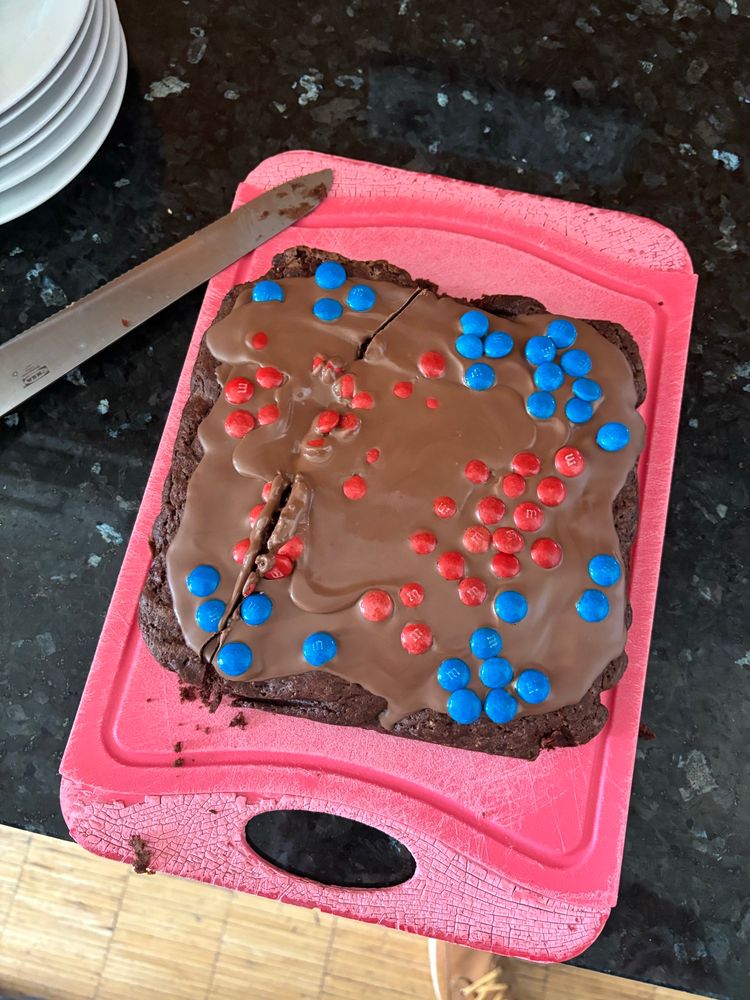
My colleagues in the @tobiasbonhoeffer.bsky.social department baked a mouse OD columns cake ❤️❤️
26.02.2025 09:23 — 👍 8 🔁 0 💬 1 📌 0
And here the rotating version of the image (1b/7)
25.02.2025 11:09 — 👍 3 🔁 0 💬 0 📌 0
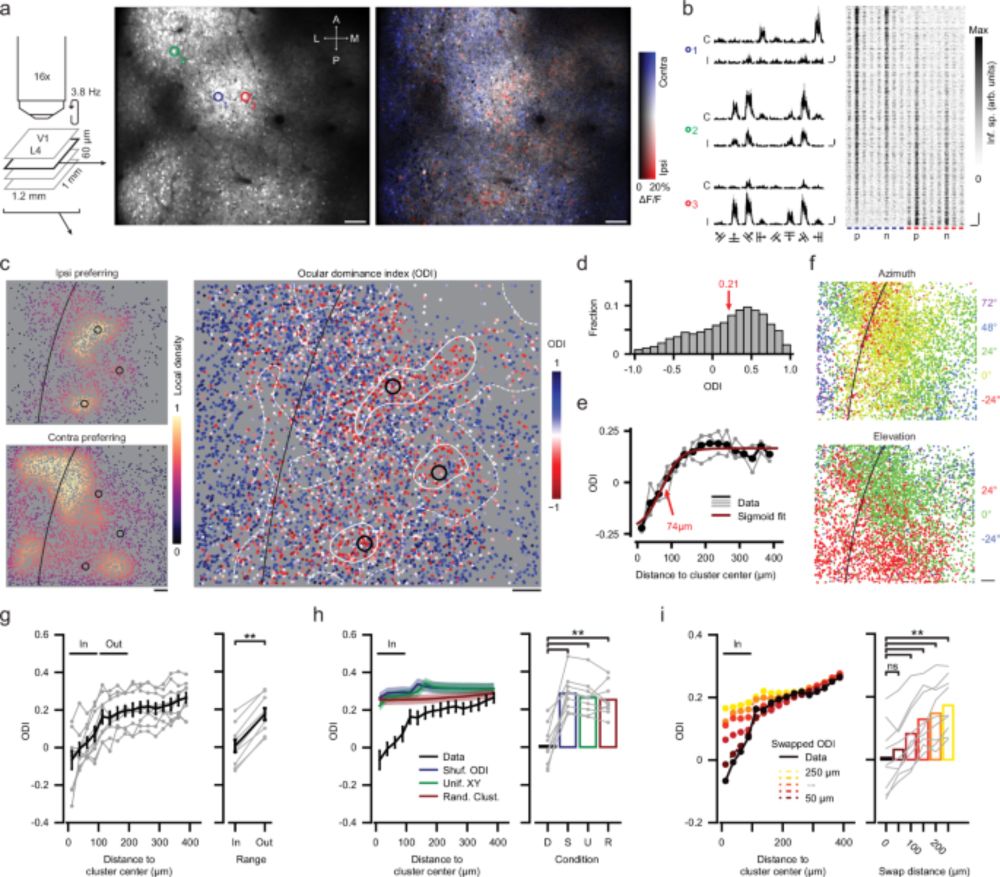
A column-like organization for ocular dominance in mouse visual cortex - Nature Communications
This study reports clusters of ipsilateral eye preferring neurons in layer 4 of mouse visual cortex, extending into layer 2/3 and upper layer 5. This column-like pattern for ocular dominance expands o...
So, it turns out that the mouse visual cortex has a columnar organization for ocular dominance! But what might be the function of such columns in general? We hope that our work inspires further investigation of the molecular, circuits and behavioral aspects of that question. (7/7)
25.02.2025 10:57 — 👍 1 🔁 0 💬 0 📌 0

From basic feature maps for ocular dominance, azimuth and elevation (top row) we produced computed feature maps for the cortical magnification factor, retinotopic distortion factor and receptive field size (bottom row). These computed features do not systematically differ in, or near, the ocular dominance columns
What else? Well, in larger mammals, the spatial arrangement of ocular dominance is related to the retinotopic and other feature maps. Interestingly, in mice we could not detect such relationships. (6/7)
25.02.2025 10:55 — 👍 1 🔁 0 💬 1 📌 0
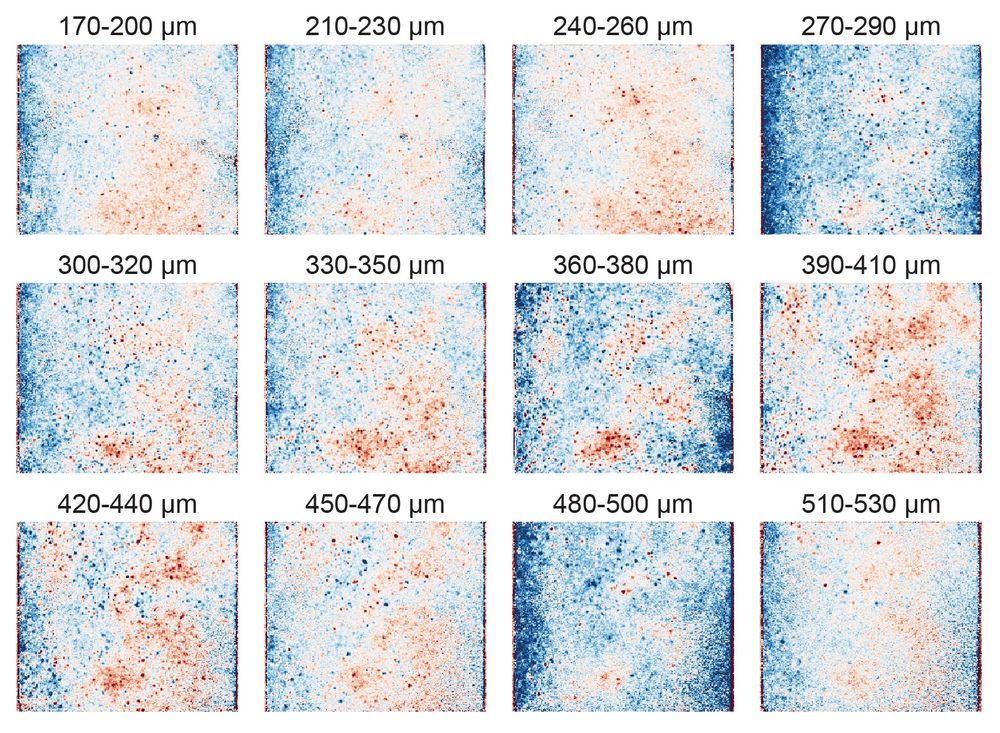
The spatial pattern of ipsilateral and contralateral eye preferring neurons is similar across the depth of the mouse visual cortex
Moreover, the clusters we identified in layer 4 extended vertically into layers 2/3 and 5, forming a columnar organization. (5/7)
25.02.2025 10:52 — 👍 1 🔁 0 💬 1 📌 0
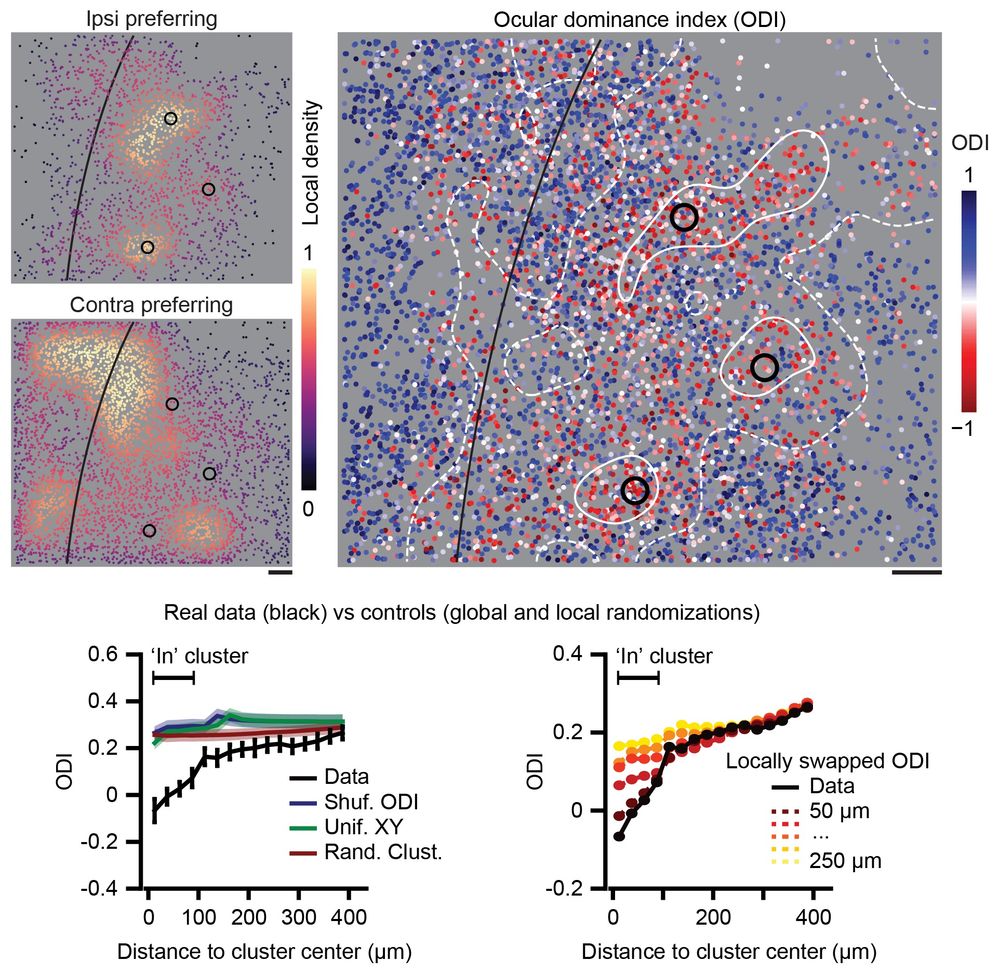
Different spatial density patterns of ipsilateral and contralateral eye preferring neurons in the mouse visual cortex
We identified the location of these ipsi-patches using a clustering algorithm. But did the data just “type out Shakespeare” by chance? No, neither randomized nor simulated data showed similar spatial distributions for ocular dominance. (4/7)
25.02.2025 10:50 — 👍 1 🔁 0 💬 1 📌 0
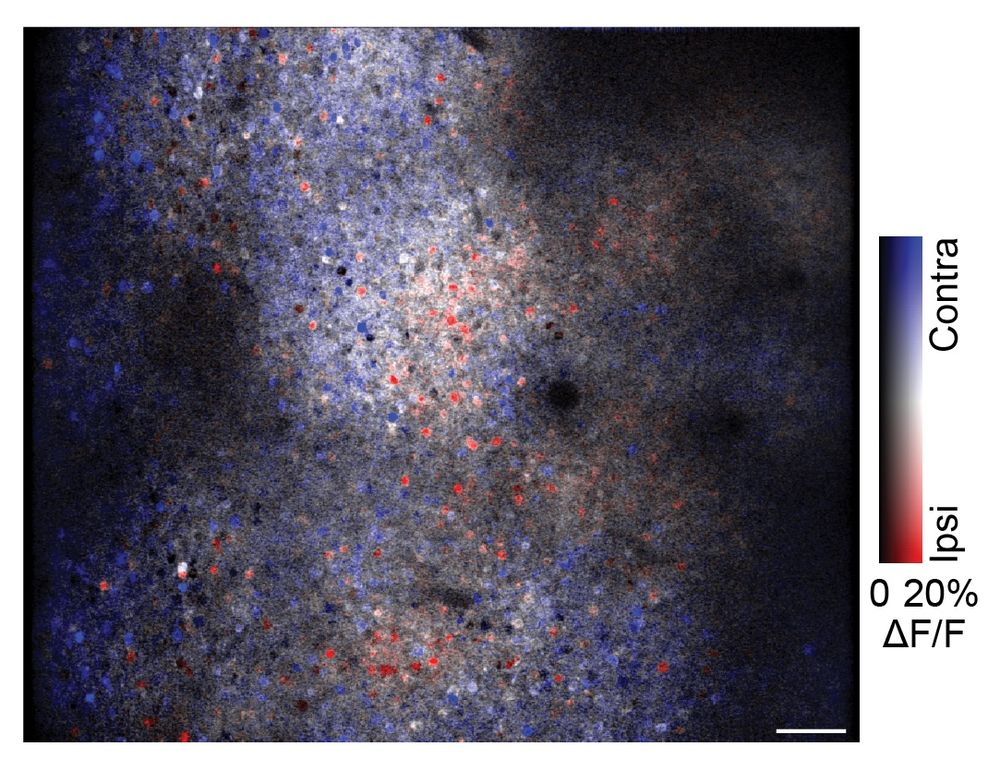
Neuronal responses in mouse visual cortex color-coded for which eye drives the strongest response, showing an uneven distribution of ipsilateral eye responsive neurons
As expected, there was a retinotopic map, but to our surprise, when we inspected the ‘visual response maps’ we also observed clear patches with mostly ipsilateral eye driven responses in layer 4. (3/7)
25.02.2025 10:48 — 👍 1 🔁 0 💬 1 📌 0
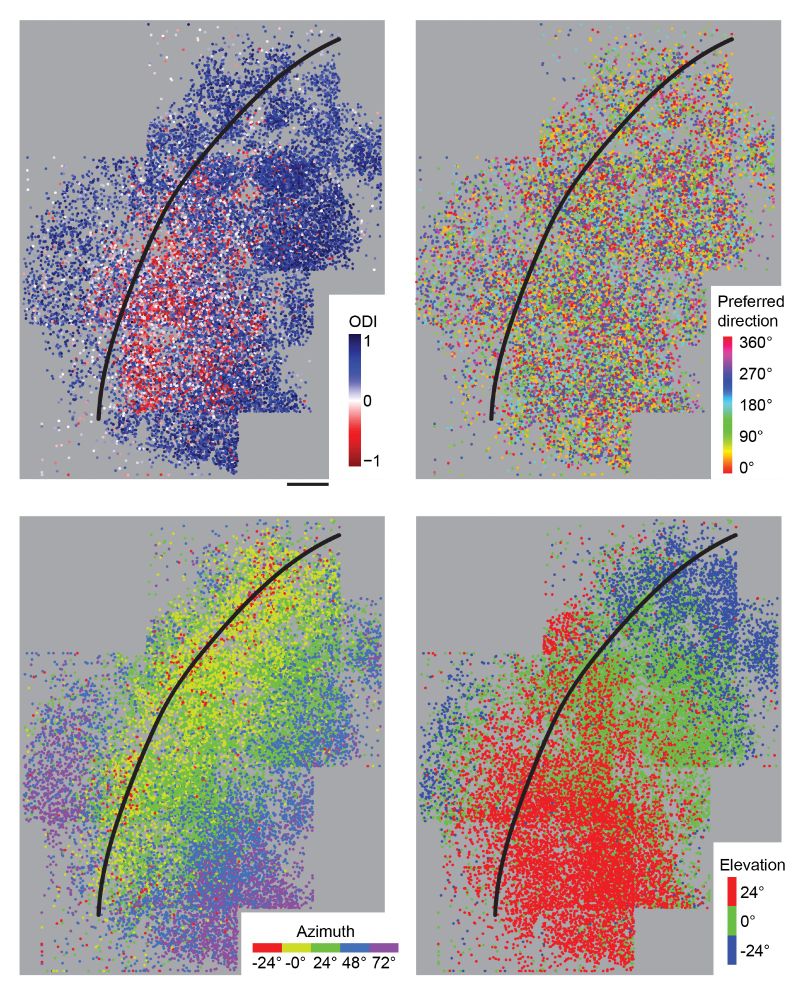
Four maps of the mouse visual cortex showing the spatial distribution of the response properties 'ocular dominance', 'preferred direction', 'azimuth' and 'elevation'
How did we find them? Using 2-photon microscopy, we mapped functional properties like retinotopy, orientation tuning, and ocular dominance across a large part of the mouse visual cortex. (2/7)
25.02.2025 10:45 — 👍 1 🔁 0 💬 1 📌 0
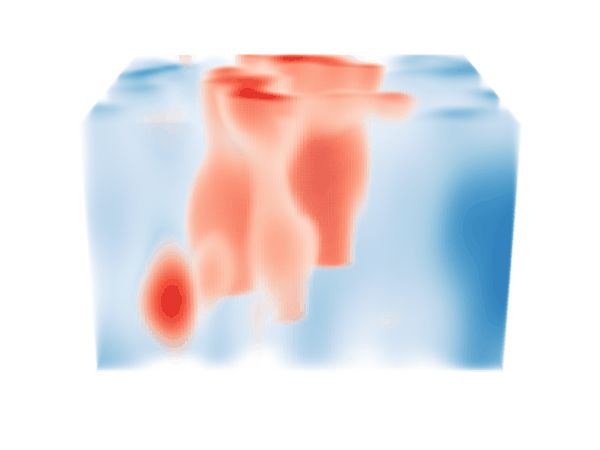
A rotating 3D-rendered volume showing ocular dominance columns as vertically extending structures (red) in the mouse visual cortex
Can the mouse visual cortex harbor a functional organization for stimulus features? TLDR: Yes, we found ocular dominance columns in this tiny cortical region! Check our paper, open access in @naturecomms.bsky.social www.nature.com/articles/s41... and/or read the 🧵 below. @mpiforbi.bsky.social (1/7)
25.02.2025 10:43 — 👍 20 🔁 9 💬 3 📌 2
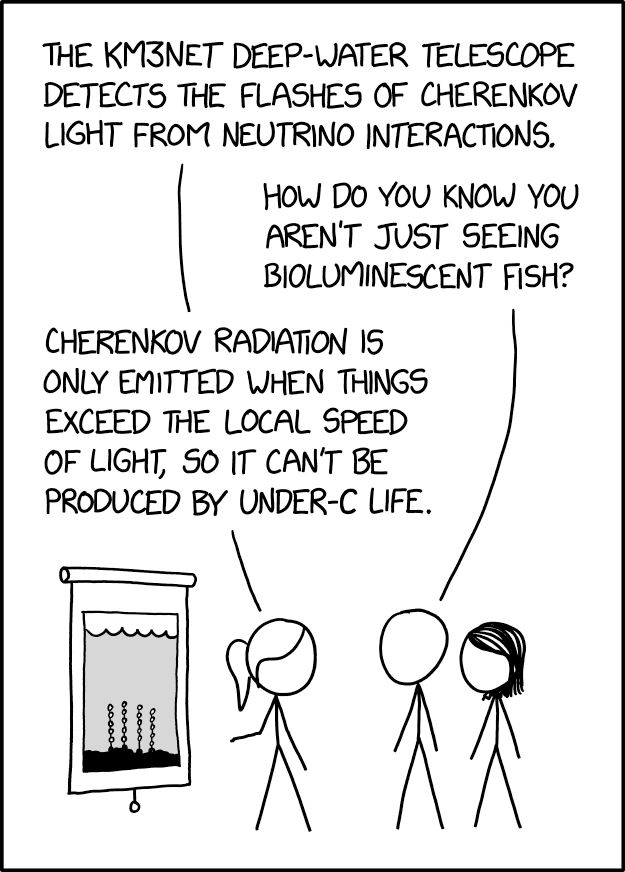
KM3NeT xkcd.com/3053
19.02.2025 17:43 — 👍 8785 🔁 855 💬 223 📌 89

Moment of zen 🏔️🌞
19.02.2025 10:43 — 👍 0 🔁 0 💬 0 📌 0

It is spring when nature doesn’t know anymore where not to flower
31.03.2024 18:55 — 👍 0 🔁 0 💬 0 📌 0

Winterwonderland 🤩
21.01.2024 17:37 — 👍 13 🔁 1 💬 0 📌 0
excited neuroscientist, mouse trainer by profession, postdoc at @sainsburywellcome.bsky.social
Neuroscientist, following circuits in neurodegeneration 🐭🔬
Neuroscientist: Layer 6, interhemispheric communication, brain atlas; Runner, Raver
Neuroscientist at the Gogolla lab, Max Planck Institute of Psychiatry. Trying to understand emotions. Doing optical things in the insula.
Neuroscientist, cactophile, wildlife photographer
Hopkins | Kavli NDI
Temporal Decision Making, Neural representations of time, timing, and time evolving value
https://sites.google.com/site/marshallshuler/
Kurt Golcuk, Elissa Sutlief, Charlie Walters, Rebekah Zhang, Shichen Zhang, Ziyi Guo, Jiayi Chen
Professor at Medical University Innsbruck interested in circuit mechanisms of CNS disorders
Computational Neuroscience at LMU Munich | https://compneurobio.org | 🇵🇱🇪🇺
Professor, Neuroscientist, Group Leader @lmumuenchen.bsky.social interested in how your brain 🧠 converts feelings into actions. 🇺🇸 in 🇩🇪. @erc.europa.eu Awardee. annaschroederlab.com
Professor at the Gatsby Unit and Sainsbury Wellcome Centre, UCL, trying to figure out how we learn
Neuroscientist @__NERF | @BiologyKULeuven | @VIBLifeSciences | @leuvenbrainins1. Opinions my own. https://bsky.app/profile/boninlab.bsky.social
Postdoc @ Champalimaud Centre for the Unknown - Chiappe Lab - Neuroscience/Sensorimotor Integration - Locomotion - VNC to brain and back - hobbies include poking bugs with glass needles 🧠🪰🦿🔬
Neuroetholgist and PhD student at MPI-Biological Intelligence studying active vision in insects
PhD student at the Gogolla Lab















